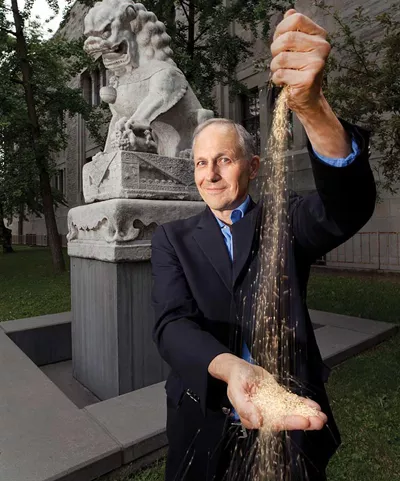
Picturing the past
Computing and archaeology are unrelated. Or are they? Could an invention of the modern age actually benefit a field that focuses on the past? The answer is yes, says a University of Toronto Mississauga researcher. And he’s proving it, artifact by artifact.
Gary Crawford, a professor in the Department of Anthropology, is interested in the long-gone settlements of East Asia. And whereas some archaeologists hunt for tools and pottery to understand past civilizations, Crawford looks for fruits, seeds and grains.
Crawford studies the relationships between people and the plants they once consumed, cultivated and collected. He sees more in charred millet seeds, for example, than the average person. Specifically, he pictures how well and whether communities sustained themselves and their ecosystems millennia ago. An important component of his research is exploring how agriculture developed.
“Plant remains tell us about life at various times,” says Crawford. “We gain an ecological view of human settlements and can discern what the plants were used for or how plants responded to human intervention. Was the agricultural system sustainable? How did it begin and how did it evolve?”
Crawford has learned of societies that successfully balanced population growth with the need to produce food. He points to China as an example. Between 3,500 and 10,000 years ago, the country underwent rapid urbanization, yet its agricultural system kept pace with the changes, making essential adjustments over millennia.
Studying such agrarian systems, however, requires careful record-keeping and Crawford, like many archaeologists, relies upon computers to manage complex data. Computers are used to document where and when an object was found, its age, use and possible connection to other items. Without this vital information, artifacts have no context — a problem with which Crawford is well-familiar.
In 2002, a fire in a Japanese archaeology centre resulted in the loss of 80,000 artifacts and destroyed many of the archival records of the Yagi Site Collection, a set of rare, ancient artifacts that was retrieved in the early 1980s by a team that included Crawford. Now, UTM is the keeper of the world’s only subset of the Yagi Collection that still has documentation available.
But computers do more than keep track of archaeological discoveries — they can also bring them to life. With support from the Henry Luce Foundation, and through a partnership with Arius 3D Inc., Crawford, the UTM Library and Department of Anthropology have created full-colour, 3-D images of objects from two of U of T’s teaching and research collections, including the Yagi Collection. Now students, researchers and the public can view exact digital replicas of many Yagi pottery fragments online.
It’s important to provide online access to the world’s archaeological findings, says Crawford. First, it protects irreplaceable artifacts from further deterioration. Second, it enables the public to see more objects and to view them in greater detail than could possibly be achieved in museums.
“Finally, we are protecting cultural heritage, the legacy of a nation or culture, so that its heritage can continue to be meaningful in the future,” Crawford says. “Archaeology isn’t just an intellectual pursuit. It’s part of a nation’s identity. It’s part of how we see ourselves.”
(This article appears in the Summer 2012 issue of Edge. Reprinted courtesy of the Office of the Vice-President (Research), University of Toronto.)
